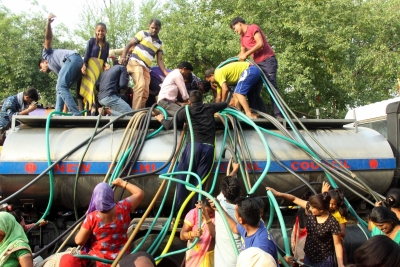DJB deploys 1,077 water tankers to deal with Delhi's peak summer demand
By IANS | Published: May 12, 2020 07:53 PM2020-05-12T19:53:15+5:302020-05-12T20:05:46+5:30
To deal with the growing demand for water amid the rise in mercury in the national capital, the Delhi ...

DJB deploys 1,077 water tankers to deal with Delhi's peak summer demand
To deal with the growing demand for water amid the rise in mercury in the national capital, the Delhi Jal Board (DJB) has pressed into service 1,077 tankers to supply water at 8,738 locations across the city.
According to an official from the DJB the body responsible for fulfilling the need of potable water in Delhi drinking water in areas where piped water supply networks are not in existence and other water deficient areas during the summer are being supplied by deploying water tankers.
"As many as 1,077 water tankers are being deployed during the peak summer, including 407 contracted stainless steel water tankers, 420 hired water tankers and 250 department stainless steel tankers," the official told .
Also, the DJB has maintained an "efficient mechanism" to monitor the movement of the tankers with GPS system. The peak summer is between April and July and with the Covid-19 infection spreading in the city, the demand for water has also increased as washing hands for 20 seconds with soap has been recommended to stop the spread of the virus.
"At least 8,738 supply points for delivery of water through water tankers have been identified for their efficient deployment. However, day-to-day locations of daily supply points could be much higher depending on the requirement and the schedule for day-to-day supply," the official said.
Also, depending on the requirement during the peak summer, daily trips of the deployed water tankers will be optimised to supplement drinking water demand in both water deficient areas and in the areas which do not have piped water supply networks.
"Tanker filling capacity at each filling point has been optimised. There will be 155 tanker filling hydrants in operation for improved efficiency in deployment of water tankers. In addition to deployment of water tankers, 117 water ATMs and e-Piaos have been installed and are in operation for availability of drinking water in deficit areas and strategic locations," the official said.
Since the outbreak of Covid-19 in the city, DJB tankers are ensuring that people follow social distancing, another official told .
"The DJB is following all the norms for social distancing and is also ensuring that people do not gather around the tankers. We ensure that constables accompany the tankers during the supply of water. They have to see that people are standing in a queue maintaining distance from each other," the official said.
While the DJB is supplying piped water to about 93 per cent of the city, about seven per cent of the area is dependent on the tankers for water supply. The areas where piped water cannot reach are mostly unauthorised colonies or JJ slum clusters where, according to the DJB, it is not feasible to deliver piped water.
According to government data accessed by , about 675 JJ clusters and 100 unauthorised colonies in the city are yet to get piped water supply.
Also, these colonies and clusters are densely populated and hence, social distancing is important. Among the 70 assembly constituencies, north-west Delhi's Kirari has the highest number of daily supply points 1,568. It is followed by south Delhi's Chhatarpur constituency having 1,406 daily supply points and Palam with 568 supply points.
The maximum temperature in Delhi has already reached 40 degree Celcius in the last few days.
( With inputs from IANS )
Open in app